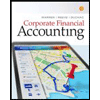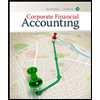
Financial Accounting
3rd Edition
ISBN: 9780078025549
Author: J. David Spiceland, Wayne M Thomas, Don Herrmann
Publisher: McGraw-Hill Education
expand_more
expand_more
format_list_bulleted
Concept explainers
Textbook Question
Chapter 2, Problem 16RQ
16. What does a T-account represent? What is the left side of the T-account called? What is the right side called?
Expert Solution & Answer
Want to see the full answer?
Check out a sample textbook solution
Students have asked these similar questions
1) Identify whethere the company is paying out dividends based on the attached statement.
2) Describe in detail how that the company’s dividend payouts have changed over the past five years.
3)Describe in detail the changes in “total equity” (representing the current “book value” of the company).
Which is not an objective of internal controls?A. Safeguard assetsB. Improve profitsC. Ensure accurate recordsD. Promote operational efficiencyneed help
Which is not an objective of internal controls?A. Safeguard assetsB. Improve profitsC. Ensure accurate recordsD. Promote operational efficiencyno ai
Chapter 2 Solutions
Financial Accounting
Ch. 2 - Prob. 1RQCh. 2 - 2.List the steps we use to measure external...Ch. 2 - 3.Each external transaction will have a dual...Ch. 2 - 4.Describe the impact of each of these external...Ch. 2 - Prob. 5RQCh. 2 - Prob. 6RQCh. 2 - Prob. 7RQCh. 2 - Prob. 8RQCh. 2 - Prob. 9RQCh. 2 - 10.Suzanne knows that an increase to an expense...
Ch. 2 - 11.What is a journal? What is a journal entry?Ch. 2 - Prob. 12RQCh. 2 - Prob. 13RQCh. 2 - Prob. 14RQCh. 2 - 15.Describe the events that correspond to the...Ch. 2 - 16.What does a T-account represent? What is the...Ch. 2 - Prob. 17RQCh. 2 - Prob. 18RQCh. 2 - Prob. 19RQCh. 2 - 20.If total debits equal total credits in the...Ch. 2 - List steps in the measurement process (LO21) Below...Ch. 2 - Balance the accounting equation (LO22) Using the...Ch. 2 - Suppose a local company has the following balance...Ch. 2 - Analyze the Impact of transactions on the...Ch. 2 - Understand the effect of debits and credits on...Ch. 2 - Prob. 2.6BECh. 2 - Record transactions (LO24) The following...Ch. 2 - Prob. 2.8BECh. 2 - Analyze T-accounts (LO25) Consider the following...Ch. 2 - Prob. 2.10BECh. 2 - Prob. 2.11BECh. 2 - Correct a trial balance (LO26) Your study partner...Ch. 2 - Listed below are several terms and phrases...Ch. 2 - Prob. 2.2ECh. 2 - Analyze the Impact of transactions on the...Ch. 2 - Analyze the Impact of transactions on the...Ch. 2 - Understand the components of retained earnings...Ch. 2 - Indicate the debit or credit balance of accounts...Ch. 2 - Associate debits and credits with external...Ch. 2 - Prob. 2.8ECh. 2 - Identify transactions (LO24) Below are recorded...Ch. 2 - Prob. 2.10ECh. 2 - Record transactions (LO24) Bearcat Construction...Ch. 2 - Correct recorded transactions (LO24) Below are...Ch. 2 - Correct recorded transactions (LO24) Below are...Ch. 2 - Prob. 2.14ECh. 2 - Post transactions to T-accounts (LO25) Consider...Ch. 2 - Identify transaction (LO25) Below are T-accounts....Ch. 2 - Prob. 2.17ECh. 2 - Prepare o trial balance (LO26) Below is the...Ch. 2 - Prob. 2.19ECh. 2 - Prob. 2.20ECh. 2 - Below is a list of activities for Jayhawk...Ch. 2 - Prob. 2.2APCh. 2 - Prob. 2.3APCh. 2 - Prob. 2.4APCh. 2 - Refer to the transactions described in P24A. Keep...Ch. 2 - Prob. 2.6APCh. 2 - Prob. 2.7APCh. 2 - Prob. 2.8APCh. 2 - Prob. 2.9APCh. 2 - Analyze the impact of transactions on the...Ch. 2 - Prob. 2.2BPCh. 2 - Prob. 2.3BPCh. 2 - Record transactions (LO24) Flip Side of P25B Eli...Ch. 2 - Prob. 2.5BPCh. 2 - Prob. 2.6BPCh. 2 - Prob. 2.7BPCh. 2 - Prob. 2.8BPCh. 2 - Prob. 2.9BPCh. 2 - Prob. 2.1APCPCh. 2 - Prob. 2.2APFACh. 2 - Prob. 2.3APFACh. 2 - Prob. 2.4APCACh. 2 - Prob. 2.5APECh. 2 - Prob. 2.6APIRCh. 2 - Prob. 2.7APWC
Knowledge Booster
Learn more about
Need a deep-dive on the concept behind this application? Look no further. Learn more about this topic, accounting and related others by exploring similar questions and additional content below.Similar questions
- Can you solve this general accounting problem using appropriate accounting principles?arrow_forwardWhich is not an objective of internal controls?A. Safeguard assetsB. Improve profitsC. Ensure accurate recordsD. Promote operational efficiency no aiarrow_forwardPlease provide the accurate answer to this financial accounting problem using appropriate methods.arrow_forward
- Please provide the correct answer to this financial accounting problem using valid calculations.arrow_forward20 Nelson and Murdock, a law firm, sells $8,000,000 of four-year, 8% bonds priced to yield 6.6%. The bonds are dated January 1, 2026, but due to some regulatory hurdles are not issued until March 1, 2026. Interest is payable on January 1 and July 1 each year. The bonds sell for $8,388,175 plus accrued interest. In mid-June, Nelson and Murdock earns an unusually large fee of $11,000,000 for one of its cases. They use part of the proceeds to buy back the bonds in the open market on July 1, 2026 after the interest payment has been made. Nelson and Murdock pays a total of $8,456,234 to reacquire the bonds and retires them. Required1. The issuance of the bonds—assume that Nelson and Murdock has adopted a policy of crediting interest expense for the accrued interest on the date of sale.2. Payment of interest and related amortization on July 1, 2026.3. Reacquisition and retirement of the bonds.arrow_forward13 Which of the following is correct about the difference between basic earnings per share (EPS) and diluted earnings per share? Question 13 options: Basic EPS uses comprehensive income in its calculation, whereas diluted EPS does not. Basic EPS is not a required disclosure, whereas diluted EPS is required disclosure. Basic EPS uses total common shares outstanding, whereas diluted EPS uses the weighted-average number of common shares. Basic EPS is not adjusted for the potential dilutive effects of complex financial structures, whereas diluted EPS is adjusted.arrow_forward
arrow_back_ios
SEE MORE QUESTIONS
arrow_forward_ios
Recommended textbooks for you
- Principles of Accounting Volume 1AccountingISBN:9781947172685Author:OpenStaxPublisher:OpenStax College
 Cornerstones of Financial AccountingAccountingISBN:9781337690881Author:Jay Rich, Jeff JonesPublisher:Cengage Learning
Cornerstones of Financial AccountingAccountingISBN:9781337690881Author:Jay Rich, Jeff JonesPublisher:Cengage Learning  Corporate Financial AccountingAccountingISBN:9781305653535Author:Carl Warren, James M. Reeve, Jonathan DuchacPublisher:Cengage Learning
Corporate Financial AccountingAccountingISBN:9781305653535Author:Carl Warren, James M. Reeve, Jonathan DuchacPublisher:Cengage Learning Corporate Financial AccountingAccountingISBN:9781337398169Author:Carl Warren, Jeff JonesPublisher:Cengage Learning
Corporate Financial AccountingAccountingISBN:9781337398169Author:Carl Warren, Jeff JonesPublisher:Cengage Learning AccountingAccountingISBN:9781337272094Author:WARREN, Carl S., Reeve, James M., Duchac, Jonathan E.Publisher:Cengage Learning,
AccountingAccountingISBN:9781337272094Author:WARREN, Carl S., Reeve, James M., Duchac, Jonathan E.Publisher:Cengage Learning,

Principles of Accounting Volume 1
Accounting
ISBN:9781947172685
Author:OpenStax
Publisher:OpenStax College

Cornerstones of Financial Accounting
Accounting
ISBN:9781337690881
Author:Jay Rich, Jeff Jones
Publisher:Cengage Learning


Corporate Financial Accounting
Accounting
ISBN:9781305653535
Author:Carl Warren, James M. Reeve, Jonathan Duchac
Publisher:Cengage Learning

Corporate Financial Accounting
Accounting
ISBN:9781337398169
Author:Carl Warren, Jeff Jones
Publisher:Cengage Learning

Accounting
Accounting
ISBN:9781337272094
Author:WARREN, Carl S., Reeve, James M., Duchac, Jonathan E.
Publisher:Cengage Learning,
The accounting cycle; Author: Alanis Business academy;https://www.youtube.com/watch?v=XTspj8CtzPk;License: Standard YouTube License, CC-BY